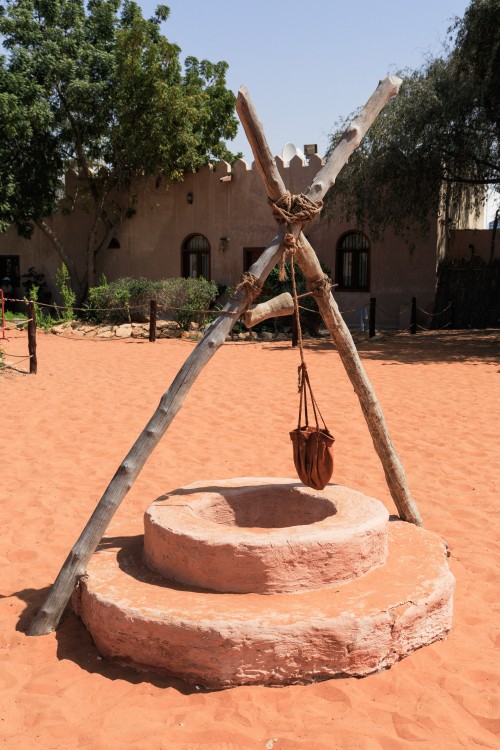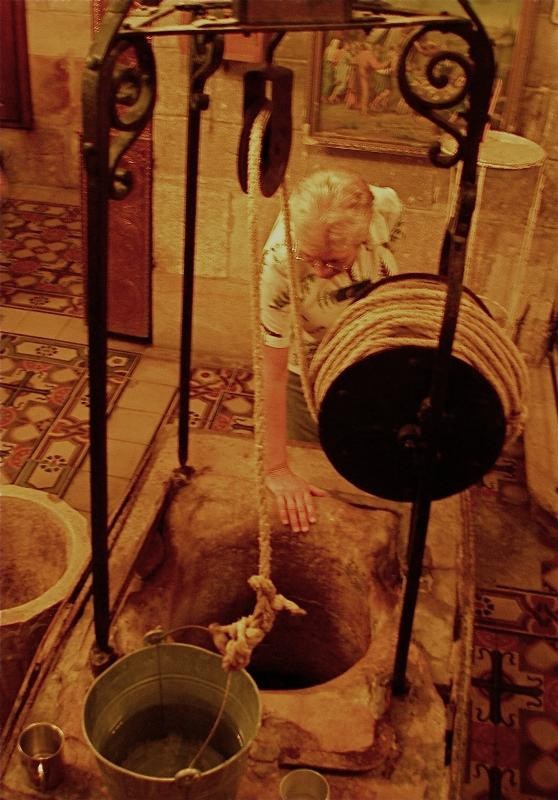John 4:1-9 “The Pharisees heard that Jesus was gaining and baptizing more disciples than John, although, in fact, it was not Jesus who baptized, but his disciples. When the Lord learned of this, he left Judea and went back once more to Galilee. Now he had to go through Samaria. So he came to a town in Samaria called Sychar, near the plot of ground Jacob had given to his son Joseph. Jacob’s well was there, and Jesus, tired as he was from the journey, sat down by the well. It was about the sixth hour. When a Samaritan woman came to draw water, Jesus said to her, ‘Will you give me a drink?’ (His disciples had gone into town to buy food.) The Samaritan woman said to him, ‘You are a Jew and I am a Samaritan woman. How can you ask me for a drink?'” (For Jews do not associate with Samaritans.) (New International Version)

This is a picture of an Arabic well with a leather bucket for drawing water that is the same as would have been used in Jesus’ time. The leather bucket mouth was held open by two crossed sticks and the larger poles may or may not have been carried by travelers, but certainly, the leather bucket attached to a long rope would be carried by a group of travelers or by a single person as is the case in our story. According to the author and scholar Kenneth E. Bailey, as late as 2008, these buckets were available in the open-air markets in Aleppo, Syria. Middle Eastern wells many times had a round cover/capstone across the top with a small hole in the middle to draw water up through. The cover/capstone with a small hole prevented sand from blowing in as well as keeping larger animals and children from falling in. Pictured below is a picture of Jacob’s well seen today in the Church of St. Photina belonging to the Greek Orthodox Church who purchased the well and its surrounding ground in 1860.

In these verses we see Jesus, a Jewish male and rabbi or teacher sitting on the wells capstone, tired and thirsty, waiting for his disciples to return from the village of Sychar with some purchased food. The inference here is that the disciples took the water bucket into town with them instead of leaving it with Jesus. As the Samaritan women approached the well to draw water to fill her water pot, culture dictated that without saying a word to the woman the male would withdraw 20′ plus from the well. This would indicate to the woman that it was safe for her to approach the well and draw water.
Jesus is speaking aloud to this woman is breaking a social taboo as a Jewish male and rabbi by talking with this woman in an uninhabited place with no witnesses. Rabbi’s typically did not speak to women in public and that included their wives. The witnesses would be male as women were not considered reliable witnesses nor were their testimony admissible in court. Kenneth E. Bailey notes that in his 40 years of life in the Middle East he never crossed that social boundary. In Jesus’ time as in many small villages in the Middle East today, a man will not make eye contact with a woman in a public place. By speaking with this woman he is also ignoring the long history of over 500 years of animosity between Jews and the Samaritans.
Stayed tuned for Part 3 posting in a few days.